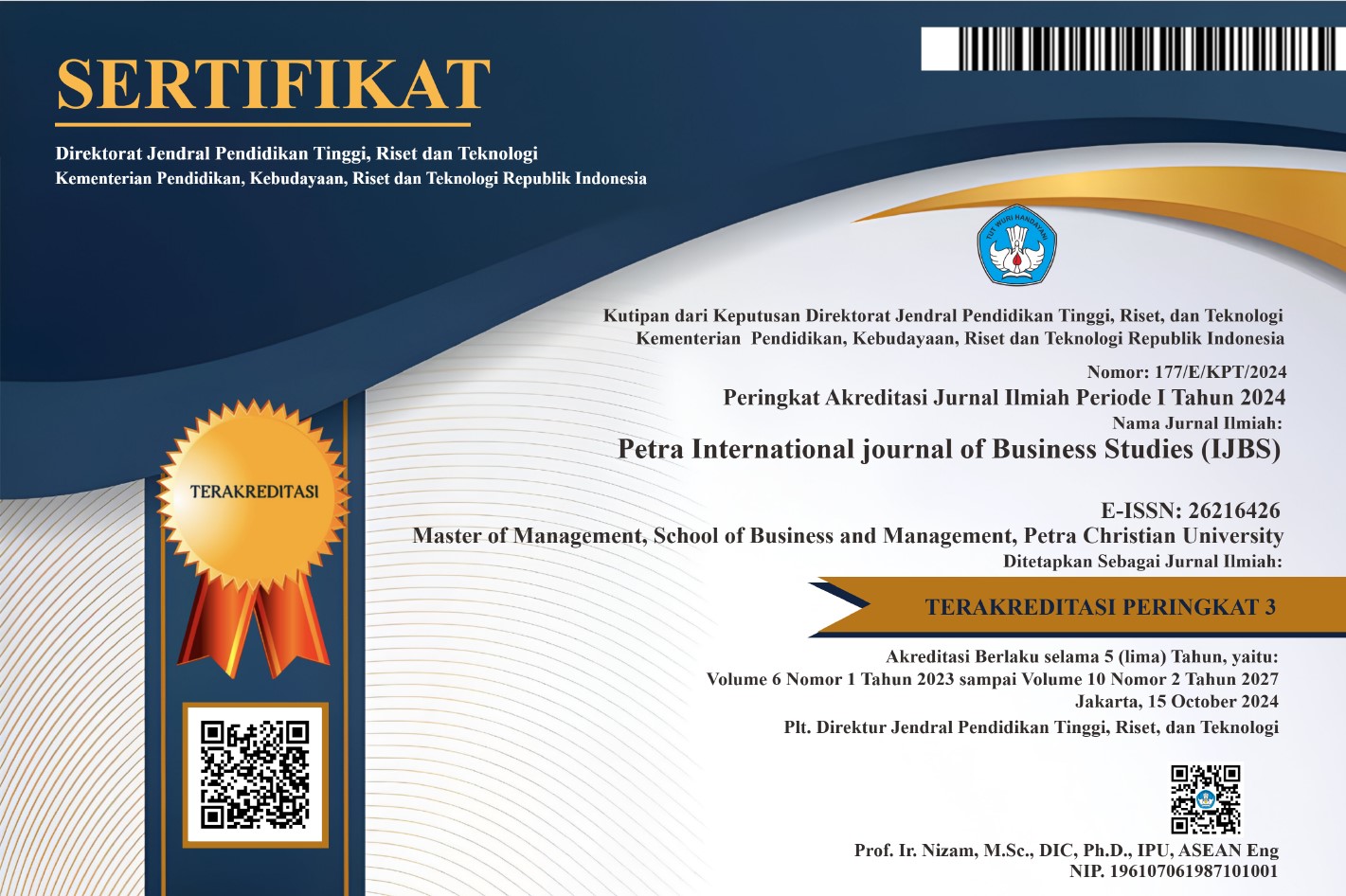The Effect of Student’s Perception of Learning Innovation on Student Engagement and Student Satisfaction
DOI:
https://doi.org/10.9744/ijbs.5.2.198-205Keywords:
Learning innovation, student engagement, student satisfaction, technology, interactionAbstract
The COVID-19 pandemic has changed how people live, including education. Due to an increase in positive cases of COVID-19, the teaching and learning process must be carried out online. However, online learning that is carried out suddenly caused by the pandemic can affect a decrease in student engagement and student satisfaction. This research aims to determine student perceptions of teaching innovations that impact student engagement and satisfaction. The online survey was distributed to 166 students of an international program at a private university in Surabaya, Indonesia. The research found that learning methods or strategies prepared by the lecturers to create learning innovation positively impact student engagement and student satisfaction. The ideal teaching method or strategy during online learning supports the interaction between the lecturer and students. Such interaction would increase student engagement, such as learning motivation, being confident in their abilities and deep understanding, and sharing learning experiences, ideas, and knowledge so that student satisfaction will be enhanced.
Downloads
References
Al-Tabany, T. I. B. 2014. Mendesain model pembelajaran inovatif, progresif dan kontekstual. (D. Trianto, Titik Triwulan Tutik (ed.); 1st ed.). Kharisma Putra Utama.
Angella, N.B., and Ricky. (2022). Do servant teachers practice what they preach? a case of academic servant leadership in a faith-based school in Indonesia. International Journal of Business Studies, 5(1), 109-117, DOI: https://doi.org/10.9744/ijbs.5.1.109-117leader
Arjomandi, A., Seufert, J., O’Brien, M., & Anwar, S. 2018. Active teaching strategies and student engagement: a comparison of traditional and non-traditional business students. E-Journal of Business Education and Scholarship of Teaching, 12(2), 120–140.
Bond, M., & Bedenlier, S. 2019. Facilitating student engagement through educational technology: towards a conceptual framework. Journal of Interactive Media in Education, 2019(1), 1–14.
Bond, M., Buntins, K., Bedenlier, S., Zawacki-Richter, O., & Kerres, M. 2020. Mapping research in student engagement and educational technology in higher education: a systematic evidence map. International Journal of Educational Techno-logy in Higher Education, 17(2), 30.
Budin, H. 1999. The computer enters the classroom. In Teachers College Record. 100(3), 656–669.
Chiu, C.-M., A, Hsu, M.-H., B, Sun, S.-Y., Lin, T.-C., C, & Sun, P. 2005. Usability, quality , value and e- learning continuance decisions related papers. Computers & Education, 45, 399–416.
Cole, M. T., Shelley, D. J., & Swartz, L. B. (2014). Online instruction, e-learning, and student satisfaction: A three year study. International Review of Research in Open and Distance Learning, 15(6), 111–131.
Gray, J. A., & DiLoreto, M. 2016. The effects of student engagement, student satisfaction, and perceived learning in online learning environ-ments. NCPEA International Journal of Educational Leadership Preparation, 11(1), 98–119.
Hair, J. F., Jr. G. Hult, Tomas M., Ringle, C. M. 2016. A primer on partial least squares structural equation modeling (PLS-SEM). in European Business Review, 2nd ed, Sage.
Hakim, A. A., & Kawamorita, H. 2020. A comparative study of satisfaction in pre and mid Covid-19 pandemic: a case study of international students in Ondokuz Mayis University, Turkey. International Journal of Economics & Strategic Management of Business Process, 17(January), 72–77.
Kahu, E. R. (2013). Framing student engagement in higher education. Studies in Higher Education, 38(5), 758–773.
Marlius, D. (2018). Pengaruh dimensi kualitas pe¬layan-an website akademik terhadap kepuasan mahasiswa pada STIE “KBP.” Jurnal Ipteks Terapan, 12(2), 116.
Means, B., and Neisler, J., with L. R. A. 2020. Digital promises. in suddenly online: a national survey of undergraduates during the Covid-19 pande-mic. Retrieved from https://digitalpromise.org/wp-content/uploads/2020/07/ELE_CoBrand_ DP_FINAL_3.pdf
Meyer, K. A. 2014. Student engagement in online learning: What works and why. ASHE Higher Education Report. Vol 40 Issue 6.
Muzakki, M.A., and Tarigan, Z.J.H. 2020. Analysis of the effect of academic service quality on student
loyalty through student satisfaction and organi-zational performance. Petra International Journal of Business Studies, 3(1), 47-53.
Purwanto, A., Fahlevi, M., Santoso, B.P., Radyawanto, S. A., & Anwar, C. 2020. Exploring the Covid-19 pandemic impact on the Indonesian student’s performance. Journal of Critical Review, 7(15), 2020–2035.
Putra, I. P. (020). Ternyata, belajar daring sudah ada sejak 1980 di Indonesia. Retrieved from. https://www.medcom.id/pendidikan/news-pendidikan/8N00jB7N-ternyata-belajar-daring-sudah-ada-sejak-1980-di-indonesia.
Rahmawati, D. (2013). Analisis Faktor-Faktor Yang Mempengaruhi Kepuasan Mahasiswa. Jurnal Economia, 9(1), 52–65.
Salmon, G. 2014. Learning innovation: A framework for transformation. European Journal of Open, Distance and e-learning, 17(2), 220–236.
Smith, K. 2011. Teaching in higher education cultivating innovative learning and teaching cultures : A question of garden design. November 2014, 37–41.
Sugiyono. (2010). Metode penelitian kuantitatif, kualitatif dan R&D (11th ed.). Alfabeta.
Trowler, V., & Trowler, P. 2010. Student engagement executive summary higher education academy student engagement project. The Higher Education Academy, July, 1–8.
Weerasinghe, I. S., & Fernando, R. L. (2017). Students’ satisfaction in higher education. American Journal of Educational Eesearch, 5(5), 533-539.
Wilkins, S., & Balakrishnan, M. S. 2013. Assessing student satisfaction in transnational higher edu-cation. International Journal of Educational Management, 27(2), 143–156.
Yusoff, M., McLeay, F., & Woodruffe-Burton, H. 2015. Quality assurance in education dimensions driving business student satisfaction in higher education. Quality Assurance in Education, 23, 86–104.
Zhou, N. 2021. Student satisfaction at australia’s universities drops to all-time low in 2020. Retrieved from https://www.theguardian.com/australia-news/2021/mar/19/student-satisfaction-at-australias-universities-drops-to-all-time-low-in-2020.
Additional Files
Published
Issue
Section
License
Copyright (c) 2022 Copyright (c) 2022 Anita Setyawati, Serli Wijaya, Deborah C. Widjaja

This work is licensed under a Creative Commons Attribution 4.0 International License.
Petra IJBS (e-ISSN: 2621-6426) is published by Master of Management program, School of Business and Management, Petra Christian University, Indonesia (MM SBM PCU).












